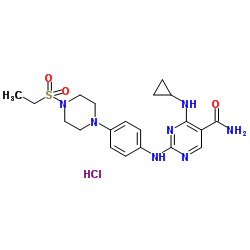Cerdulatinib hydrochloride

Cerdulatinib hydrochloride structure
|
Common Name | Cerdulatinib hydrochloride | ||
|---|---|---|---|---|
| CAS Number | 1369761-01-2 | Molecular Weight | 481.999 | |
| Density | N/A | Boiling Point | N/A | |
| Molecular Formula | C20H28ClN7O3S | Melting Point | N/A | |
| MSDS | N/A | Flash Point | N/A | |
Use of Cerdulatinib hydrochlorideCerdulatinib hydrochloride (PRT062070) is a selective, oral active and reversible ATP-competitive inhibitor of dual SYK and JAK, with the IC50s of 32 nM, 0.5 nM, 12 nM, 6 nM and 8 nM for SYK and Tyk2, JAK1, 2, 3, respectively. Cerdulatinib hydrochloride could be used to research autoimmune disease and B-cell malignancies[1][2]. |
| Name | 4-(Cyclopropylamino)-2-({4-[4-(ethylsulfonyl)-1-piperazinyl]phenyl}amino)-5-pyrimidinecarboxamide hydrochloride (1:1) |
|---|---|
| Synonym | More Synonyms |
| Description | Cerdulatinib hydrochloride (PRT062070) is a selective, oral active and reversible ATP-competitive inhibitor of dual SYK and JAK, with the IC50s of 32 nM, 0.5 nM, 12 nM, 6 nM and 8 nM for SYK and Tyk2, JAK1, 2, 3, respectively. Cerdulatinib hydrochloride could be used to research autoimmune disease and B-cell malignancies[1][2]. |
|---|---|
| Related Catalog | |
| Target |
Tyk2:0.5 nM (IC50) JAK1:12 nM (IC50) JAK2:6 nM (IC50) JAK3:8 nM (IC50) SYK:32 nM (IC50) MST1:4 nM (IC50) ARK5:4 nM (IC50) MLK1:5 nM (IC50) FMS:5 nM (IC50) AMPK:6 nM (IC50) TBK1:10 nM (IC50) MARK1:10 nM (IC50) PAR1B-a:13 nM (IC50) TSSK:14 nM (IC50) MST2:15 nM (IC50) GCK:18 nM (IC50) JNK3:18 nM (IC50) Rsk2:20 nM (IC50) Rsk4:28 nM (IC50) CHK1:42 nM (IC50) Flt4:51 nM (IC50) Flt3:90 nM (IC50) Ret:105 nM (IC50) Itk:194 nM (IC50) |
| In Vitro | Cerdulatinib (0.03-4 μM) inhibits ERK Y204 phosphorylation with an IC50 of 0.5 μM and reduces the ability to upregulate cellsurface expression of the early activation marker CD69 with an IC50 of 0.11 μM in B cells in human whole blood[1]. Cerdulatinib (0.015-2 μM) inhibits FcεRI-mediated basophil degranulation with an IC50 of 0.12 μM[1]. Cerdulatinib (0.5-4 μM) exhibits differential potency against cytokine JAK/STAT signaling pathways[1]. Cerdulatinib (0-15 μM; 72 hours) results in viability effects similar to that of the combines SYK plus JAK-selective inhibition[1]. Cerdulatinib (1-3 μM; 48 hours) induces apoptosis in BCR-signaling competent non-Hodgkin lymphoma (NHL) cell lines[1]. Cell Viability Assay[1] Cell Line: SU-DHL4; SU-DHL6; Ramosand and Daudi cells Concentration: 0, 1, 3 μM Incubation Time: 48 hours Result: Inhibits cells viability with the IC50s of 0.73-1.39 μM. Apoptosis Analysis[1] Cell Line: SU-DHL4, SU-DHL6, and Ramos cells Concentration: 0, 1.6, 5.0, 15 μM Incubation Time: 72 hours Result: Induced SU-DHL4, SU-DHL6, and Ramos cells apoptosis. |
| In Vivo | Cerdulatinib (0.5-5 mg/kg; twice daily p.o. for 2 weeks) elicits dose-dependent efficacy in the rat collagen-induced arthritis (CIA) model[1]. Cerdulatinib ( mg/kg; twice daily p.o. for 5 days) blocks BCR-induced B-cell activation and splenomegaly in mice[1]. Animal Model: Female Lewis rats (7-8 weeks old; 159-187 g) are immunized[1] Dosage: 0, 0.5, 1.5, 3, 5 mg/kg Administration: Oral gavage twice daily for 2 weeks Result: Modulated inflammation in the rat CIA treatment model. Affected anticollagen antibody formation. Animal Model: Balb/c mice are received BCR stimulation[1] Dosage: 0, 1, 5, 15, 20, 30 mg/kg Administration: Oral gavage twice daily for 5 days Result: Suppressed upregulation of splenic B-cell surface CD80/86 and CD69 by>60%. Inhibited mouse splenomegaly in a dose- and concentration-dependent manner. |
| References |
| Molecular Formula | C20H28ClN7O3S |
|---|---|
| Molecular Weight | 481.999 |
| Exact Mass | 481.166290 |
| InChIKey | IYULGYKOHUAYCG-UHFFFAOYSA-N |
| SMILES | CCS(=O)(=O)N1CCN(c2ccc(Nc3ncc(C(N)=O)c(NC4CC4)n3)cc2)CC1.Cl |
| Storage condition | -20℃ |
| 5-Pyrimidinecarboxamide, 4-(cyclopropylamino)-2-[[4-[4-(ethylsulfonyl)-1-piperazinyl]phenyl]amino]-, hydrochloride (1:1) |
| 4-(Cyclopropylamino)-2-({4-[4-(ethylsulfonyl)-1-piperazinyl]phenyl}amino)-5-pyrimidinecarboxamide hydrochloride (1:1) |
| Cerdulatinib hydrochloride |